RabbitMQ详解与Java实现
一、RabbitMQ介绍
1.1 现存问题
- 服务调用:两个服务调用时,我们可以通过传统的HTTP方式,让服务A直接去调用服务B的接口,但是这种方式是同步的方式,虽然可以采用SpringBoot提供的@Async注解实现异步调用,但是这种方式无法确保请求一定回访问到服务B的接口。那如何保证服务A的请求信息一定能送达到服务B去完成一些业务操作呢?| 如何实现异步调用

- 海量请求:在我们在做一些秒杀业务时,可能会在某个时间点突然出现大量的并发请求,这可能已经远远超过服务器的并发瓶颈,这时我们需要做一些削峰的操作,也就是将大量的请求缓冲到一个队列中,然后慢慢的消费掉。如何提供一个可以存储千万级别请求的队列呢?

- 在微服务架构下,可能一个业务会出现同时调用多个其他服务的场景,而且这些服务之间一般会用到Feign的方式进行轻量级的通讯,如果存在一个业务,用户创建订单成功后,还需要去给用户添加积分、通知商家、通知物流系统、扣减商品库存,而在执行这个操作时,如果任意一个服务出现了问题,都会导致整体的下单业务失败,并且会导致给用户反馈的时间延长。这时就造成了服务之间存在一个较高的耦合性的问题。如何可以降低服务之间的耦合性呢?
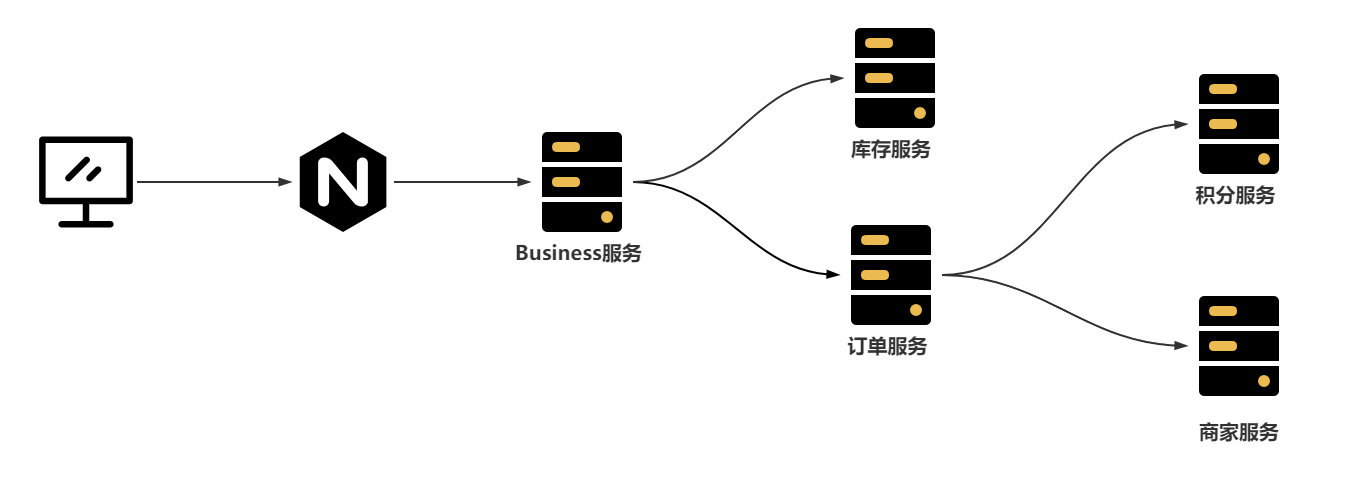
1.2 处理问题
RabbitMQ就可以解决上述的全部问题
- 服务之间如何想实现可靠的异步调用,可以通过RabbitMQ的方式实现,服务A只需要保证可以把消息发送到RabbitMQ的队列中,服务B就一定会消费到队列中的消息只不过会存在一定的延时。| 异步访问

- 忽然的海量请求可以存储在RabbitMQ的队列中,然后由消费者慢慢消费掉,RabbitMQ的队列本身就可以存储上千万条消息

- 在调用其他服务时,如果允许延迟效果的出现,可以将消息发送到RabbitMQ中,再由消费者慢慢消费| 服务解耦

1.3 RabbitMQ介绍
百度百科:
RabbitMQ是实现了高级消息队列协议(AMQP)的开源消息代理软件(亦称面向消息的中间件)。RabbitMQ服务器是用Erlang语言编写的,而集群和故障转移是构建在开放电信平台框架上的。所有主要的编程语言均有与代理接口通讯的客户端库。
首先RabbitMQ基于AMQP协议开发,所以很多基于AMQP协议的功能RabbitMQ都是支持的,比如SpringCloud中的消息总线bus
其次RabbitMQ是基于Erlang编写,这是也是RabbitMQ天生的优势,Erlang被称为面向并发编程的语言,并发能力极强,在众多的MQ中,RabbitMQ的延迟特别低,在微秒级别,所以一般的业务处理RabbitMQ比Kafka和RocketMQ更有优势。
最后RabbitMQ提供自带了图形化界面,操作方便,还自带了多种集群模式,可以保证RabbitMQ的高可用,并且SpringBoot默认就整合RabbitMQ,使用简单方便。
二、RabbitMQ安装
2.1 安装RabbitMQ
这里推荐搭建采用Docker的方式在Linux中安装RabbitMQ,如果对Docker不了解,推荐去学习一下Docker的应用,不然学习其他的知识时,安装的成本都特别高,这里我们就采用Docker的方式安装RabbitMQ。
直接使用docker-compose.yml文件即可安装RabbitMQ服务
version: '3.1'
services:
rabbitmq:
restart: always
image: daocloud.io/library/rabbitmq:3.8.8
volumes:
- ./data/:/var/lib/rabbitmq/
- ./log/:/var/log/rabbitmq/log/
ports:
- 15672:15672
- 5672:5672
执行 docker-compose up -d运行
测试效果:curl localhost:5672
| 查看效果 |
|---|
 |
2.2 开启图形化界面
默认情况下,当前镜像的图形化界面默认没有开启,需要进入到容器内部开启图形化管理界面
| 启动图形化界面插件 |
|---|
 |
 |
通过浏览器访问15672,查看图形化界面
| 查看登录页面 |
|---|
 |
默认用户和密码均为:guest,查看首页
| 查看首页 |
|---|
 |
三、RabbitMQ构架
RabbitMQ的架构可以查看官方地址:https://rabbitmq.com/tutorials/amqp-concepts.html
| 官方简单架构 |
|---|
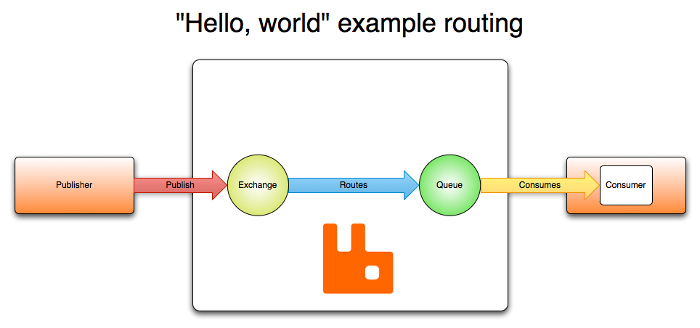 |
可以看出RabbitMQ中主要分为三个角色:
- Publisher:消息的发布者,将消息发布到RabbitMQ中的Exchange
- RabbitMQ服务:Exchange接收Publisher的消息,并且根据Routes策略将消息转发到Queue中
- Consumer:消息的消费者,监听Queue中的消息并进行消费
官方提供的架构图相对简洁,我们可以自己画一份相对完整一些的架构图:
| RabbitMQ架构图 |
|---|
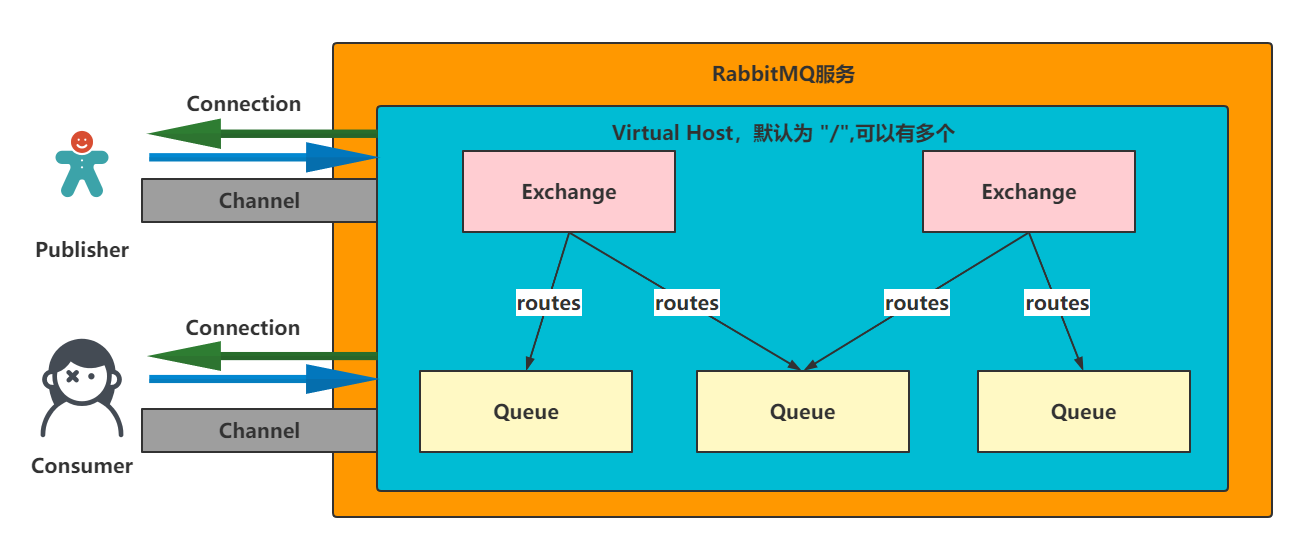 |
可以看出Publisher和Consumer都是单独和RabbitMQ服务中某一个Virtual Host建立Connection的客户端
后续通过Connection可以构建Channel通道,用来发布、接收消息
一个Virtual Host中可以有多个Exchange和Queue,Exchange可以同时绑定多个Queue
在基于架构图查看图形化界面,会更加清晰
| 图形化界面信息 |
|---|
 |
四、RabbitMQ通讯方式
RabbitMQ提供了很多中通讯方式,依然可以去官方查看:https://rabbitmq.com/getstarted.html
| 七种通讯方式 |
|---|
 |
4.1 RabbitMQ提供的通讯方式
- Hello World!:为了入门操作!
- Work queues:一个队列被多个消费者消费
- Publish/Subscribe:手动创建Exchange(FANOUT)
- Routing:手动创建Exchange(DIRECT)
- Topics:手动创建Exchange(TOPIC)
- RPC:RPC方式
- Publisher Confirms:保证消息可靠性
4.2 构建Connection工具类
-
导入依赖:amqp-client,junit
<dependencies> <dependency> <groupId>com.rabbitmq</groupId> <artifactId>amqp-client</artifactId> <version>5.9.0</version> </dependency> <dependency> <groupId>junit</groupId> <artifactId>junit</artifactId> <version>4.12</version> </dependency> </dependencies> -
构建工具类:
package com.mashibing.util; import com.rabbitmq.client.Connection; import com.rabbitmq.client.ConnectionFactory; import java.io.IOException; import java.util.concurrent.TimeoutException; /** * @author zjw * @description */ public class RabbitMQConnectionUtil { public static final String RABBITMQ_HOST = "192.168.11.32"; public static final int RABBITMQ_PORT = 5672; public static final String RABBITMQ_USERNAME = "guest"; public static final String RABBITMQ_PASSWORD = "guest"; public static final String RABBITMQ_VIRTUAL_HOST = "/"; /** * 构建RabbitMQ的连接对象 * @return */ public static Connection getConnection() throws Exception { //1. 创建Connection工厂 ConnectionFactory factory = new ConnectionFactory(); //2. 设置RabbitMQ的连接信息 factory.setHost(RABBITMQ_HOST); factory.setPort(RABBITMQ_PORT); factory.setUsername(RABBITMQ_USERNAME); factory.setPassword(RABBITMQ_PASSWORD); factory.setVirtualHost(RABBITMQ_VIRTUAL_HOST); //3. 返回连接对象 Connection connection = factory.newConnection(); return connection; } }
4.3 Hello World
| 通讯方式 |
|---|
 |
生产者:
package com.mashibing.helloworld;
import com.mashibing.util.RabbitMQConnectionUtil;
import com.rabbitmq.client.Channel;
import com.rabbitmq.client.Connection;
import org.junit.Test;
/**
* @author zjw
* @description
* @date 2022/1/24 22:54
*/
public class Publisher {
public static final String QUEUE_NAME = "hello";
@Test
public void publish() throws Exception {
//1. 获取连接对象
Connection connection = RabbitMQConnectionUtil.getConnection();
//2. 构建Channel
Channel channel = connection.createChannel();
//3. 构建队列
channel.queueDeclare(QUEUE_NAME,false,false,false,null);
//4. 发布消息
String message = "Hello World!";
channel.basicPublish("",QUEUE_NAME,null,message.getBytes());
System.out.println("消息发送成功!");
}
}
消费者:
package com.mashibing.helloworld;
import com.mashibing.util.RabbitMQConnectionUtil;
import com.rabbitmq.client.*;
import org.junit.Test;
import java.io.IOException;
/**
* @author zjw
* @description
* @date 2022/1/24 23:02
*/
public class Consumer {
@Test
public void consume() throws Exception {
//1. 获取连接对象
Connection connection = RabbitMQConnectionUtil.getConnection();
//2. 构建Channel
Channel channel = connection.createChannel();
//3. 构建队列
channel.queueDeclare(Publisher.QUEUE_NAME,false,false,false,null);
//4. 监听消息
DefaultConsumer callback = new DefaultConsumer(channel){
@Override
public void handleDelivery(String consumerTag, Envelope envelope, AMQP.BasicProperties properties, byte[] body) throws IOException {
System.out.println("消费者获取到消息:" + new String(body,"UTF-8"));
}
};
channel.basicConsume(Publisher.QUEUE_NAME,true,callback);
System.out.println("开始监听队列");
System.in.read();
}
}
4.4 Work Queues
| WorkQueues需要学习的内容 |
|---|
 |
-
生产者:生产者和Hello World的形式是一样的,都是将消息推送到默认交换机。
-
消费者:让消费者关闭自动ack,并且设置消息的流控,最终实现消费者可以尽可能去多消费消息
package com.mashibing.workqueues; import com.mashibing.util.RabbitMQConnectionUtil; import com.rabbitmq.client.*; import org.junit.Test; import java.io.IOException; /** * @author zjw * @description * @date 2022/1/25 19:52 */ public class Consumer { @Test public void consume1() throws Exception { //1. 获取连接对象 Connection connection = RabbitMQConnectionUtil.getConnection(); //2. 构建Channel Channel channel = connection.createChannel(); //3. 构建队列 channel.queueDeclare(Publisher.QUEUE_NAME,false,false,false,null); //3.5 设置消息的流控 channel.basicQos(3); //4. 监听消息 DefaultConsumer callback = new DefaultConsumer(channel){ @Override public void handleDelivery(String consumerTag, Envelope envelope, AMQP.BasicProperties properties, byte[] body) throws IOException { try { Thread.sleep(100); } catch (InterruptedException e) { e.printStackTrace(); } System.out.println("消费者1号-获取到消息:" + new String(body,"UTF-8")); channel.basicAck(envelope.getDeliveryTag(),false); } }; channel.basicConsume(Publisher.QUEUE_NAME,false,callback); System.out.println("开始监听队列"); System.in.read(); } @Test public void consume2() throws Exception { //1. 获取连接对象 Connection connection = RabbitMQConnectionUtil.getConnection(); //2. 构建Channel Channel channel = connection.createChannel(); //3. 构建队列 channel.queueDeclare(Publisher.QUEUE_NAME,false,false,false,null); channel.basicQos(3); //4. 监听消息 DefaultConsumer callback = new DefaultConsumer(channel){ @Override public void handleDelivery(String consumerTag, Envelope envelope, AMQP.BasicProperties properties, byte[] body) throws IOException { try { Thread.sleep(1000); } catch (InterruptedException e) { e.printStackTrace(); } System.out.println("消费者2号-获取到消息:" + new String(body,"UTF-8")); channel.basicAck(envelope.getDeliveryTag(),false); } }; channel.basicConsume(Publisher.QUEUE_NAME,false,callback); System.out.println("开始监听队列"); System.in.read(); } }
4.5 Publish/Subscribe
| 自定义一个交换机 |
|---|
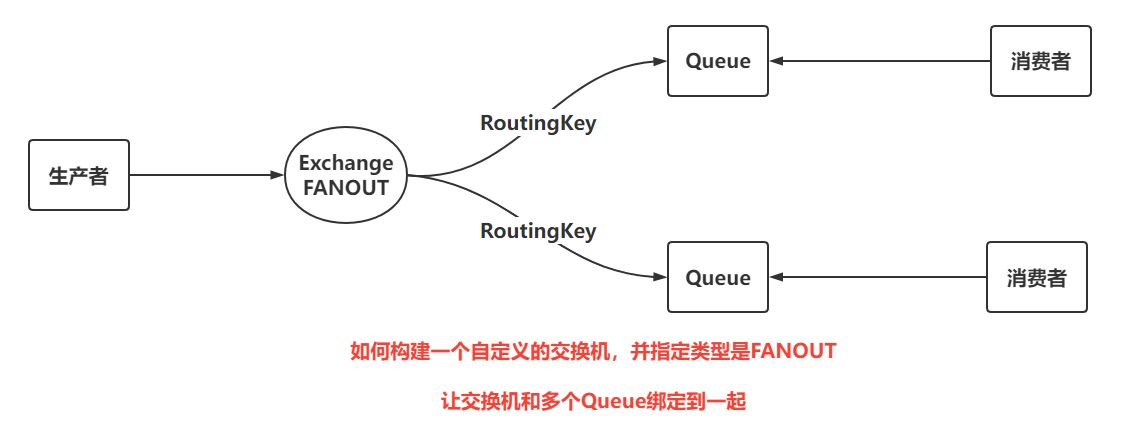 |
生产者:自行构建Exchange并绑定指定队列(FANOUT类型)
package com.mashibing.pubsub;
import com.mashibing.util.RabbitMQConnectionUtil;
import com.rabbitmq.client.BuiltinExchangeType;
import com.rabbitmq.client.Channel;
import com.rabbitmq.client.Connection;
import org.junit.Test;
/**
* @author zjw
* @description
* @date 2022/1/25 20:08
*/
public class Publisher {
public static final String EXCHANGE_NAME = "pubsub";
public static final String QUEUE_NAME1 = "pubsub-one";
public static final String QUEUE_NAME2 = "pubsub-two";
@Test
public void publish() throws Exception {
//1. 获取连接对象
Connection connection = RabbitMQConnectionUtil.getConnection();
//2. 构建Channel
Channel channel = connection.createChannel();
//3. 构建交换机
channel.exchangeDeclare(EXCHANGE_NAME, BuiltinExchangeType.FANOUT);
//4. 构建队列
channel.queueDeclare(QUEUE_NAME1,false,false,false,null);
channel.queueDeclare(QUEUE_NAME2,false,false,false,null);
//5. 绑定交换机和队列,使用的是FANOUT类型的交换机,绑定方式是直接绑定
channel.queueBind(QUEUE_NAME1,EXCHANGE_NAME,"");
channel.queueBind(QUEUE_NAME2,EXCHANGE_NAME,"");
//6. 发消息到交换机
channel.basicPublish(EXCHANGE_NAME,"45jk6h645jk",null,"publish/subscribe!".getBytes());
System.out.println("消息成功发送!");
}
}
4.6 Routing
| DIRECT类型Exchange |
|---|
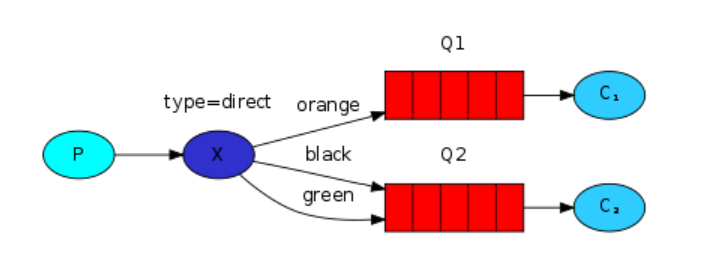 |
生产者:在绑定Exchange和Queue时,需要指定好routingKey,同时在发送消息时,也指定routingKey,只有routingKey一致时,才会把指定的消息路由到指定的Queue
package com.mashibing.routing;
import com.mashibing.util.RabbitMQConnectionUtil;
import com.rabbitmq.client.BuiltinExchangeType;
import com.rabbitmq.client.Channel;
import com.rabbitmq.client.Connection;
import org.junit.Test;
/**
* @author zjw
* @description
* @date 2022/1/25 20:20
*/
public class Publisher {
public static final String EXCHANGE_NAME = "routing";
public static final String QUEUE_NAME1 = "routing-one";
public static final String QUEUE_NAME2 = "routing-two";
@Test
public void publish() throws Exception {
//1. 获取连接对象
Connection connection = RabbitMQConnectionUtil.getConnection();
//2. 构建Channel
Channel channel = connection.createChannel();
//3. 构建交换机
channel.exchangeDeclare(EXCHANGE_NAME, BuiltinExchangeType.DIRECT);
//4. 构建队列
channel.queueDeclare(QUEUE_NAME1,false,false,false,null);
channel.queueDeclare(QUEUE_NAME2,false,false,false,null);
//5. 绑定交换机和队列
channel.queueBind(QUEUE_NAME1,EXCHANGE_NAME,"ORANGE");
channel.queueBind(QUEUE_NAME2,EXCHANGE_NAME,"BLACK");
channel.queueBind(QUEUE_NAME2,EXCHANGE_NAME,"GREEN");
//6. 发消息到交换机
channel.basicPublish(EXCHANGE_NAME,"ORANGE",null,"大橙子!".getBytes());
channel.basicPublish(EXCHANGE_NAME,"BLACK",null,"黑布林大狸子".getBytes());
channel.basicPublish(EXCHANGE_NAME,"WHITE",null,"小白兔!".getBytes());
System.out.println("消息成功发送!");
}
}
4.7 Topic
| Topic模式 |
|---|
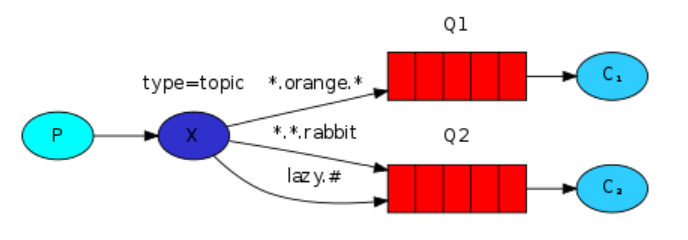 |
生产者:TOPIC类型可以编写带有特殊意义的routingKey的绑定方式
package com.mashibing.topics;
import com.mashibing.util.RabbitMQConnectionUtil;
import com.rabbitmq.client.BuiltinExchangeType;
import com.rabbitmq.client.Channel;
import com.rabbitmq.client.Connection;
import org.junit.Test;
/**
* @author zjw
* @description
* @date 2022/1/25 20:28
*/
public class Publisher {
public static final String EXCHANGE_NAME = "topic";
public static final String QUEUE_NAME1 = "topic-one";
public static final String QUEUE_NAME2 = "topic-two";
@Test
public void publish() throws Exception {
//1. 获取连接对象
Connection connection = RabbitMQConnectionUtil.getConnection();
//2. 构建Channel
Channel channel = connection.createChannel();
//3. 构建交换机
channel.exchangeDeclare(EXCHANGE_NAME, BuiltinExchangeType.TOPIC);
//4. 构建队列
channel.queueDeclare(QUEUE_NAME1,false,false,false,null);
channel.queueDeclare(QUEUE_NAME2,false,false,false,null);
//5. 绑定交换机和队列,
// TOPIC类型的交换机在和队列绑定时,需要以aaa.bbb.ccc..方式编写routingkey
// 其中有两个特殊字符:*(相当于占位符),#(相当通配符)
channel.queueBind(QUEUE_NAME1,EXCHANGE_NAME,"*.orange.*");
channel.queueBind(QUEUE_NAME2,EXCHANGE_NAME,"*.*.rabbit");
channel.queueBind(QUEUE_NAME2,EXCHANGE_NAME,"lazy.#");
//6. 发消息到交换机
channel.basicPublish(EXCHANGE_NAME,"big.orange.rabbit",null,"大橙兔子!".getBytes());
channel.basicPublish(EXCHANGE_NAME,"small.white.rabbit",null,"小白兔".getBytes());
channel.basicPublish(EXCHANGE_NAME,"lazy.dog.dog.dog.dog.dog.dog",null,"懒狗狗狗狗狗狗".getBytes());
System.out.println("消息成功发送!");
}
}
4.8 RPC(了解)
因为两个服务在交互时,可以尽量做到Client和Server的解耦,通过RabbitMQ进行解耦操作
需要让Client发送消息时,携带两个属性:
- replyTo告知Server将相应信息放到哪个队列
- correlationId告知Server发送相应消息时,需要携带位置标示来告知Client响应的信息
| RPC方式 |
|---|
 |
客户端:
package com.mashibing.rpc;
import com.mashibing.util.RabbitMQConnectionUtil;
import com.rabbitmq.client.*;
import org.junit.Test;
import java.io.IOException;
import java.util.UUID;
/**
* @author zjw
* @description
* @date 2022/2/8 20:03
*/
public class Publisher {
public static final String QUEUE_PUBLISHER = "rpc_publisher";
public static final String QUEUE_CONSUMER = "rpc_consumer";
@Test
public void publish() throws Exception {
//1. 获取连接对象
Connection connection = RabbitMQConnectionUtil.getConnection();
//2. 构建Channel
Channel channel = connection.createChannel();
//3. 构建队列
channel.queueDeclare(QUEUE_PUBLISHER,false,false,false,null);
channel.queueDeclare(QUEUE_CONSUMER,false,false,false,null);
//4. 发布消息
String message = "Hello RPC!";
String uuid = UUID.randomUUID().toString();
AMQP.BasicProperties props = new AMQP.BasicProperties()
.builder()
.replyTo(QUEUE_CONSUMER)
.correlationId(uuid)
.build();
channel.basicPublish("",QUEUE_PUBLISHER,props,message.getBytes());
channel.basicConsume(QUEUE_CONSUMER,false,new DefaultConsumer(channel){
@Override
public void handleDelivery(String consumerTag, Envelope envelope, AMQP.BasicProperties properties, byte[] body) throws IOException {
String id = properties.getCorrelationId();
if(id != null && id.equalsIgnoreCase(uuid)){
System.out.println("接收到服务端的响应:" + new String(body,"UTF-8"));
}
channel.basicAck(envelope.getDeliveryTag(),false);
}
});
System.out.println("消息发送成功!");
System.in.read();
}
}
服务端:
package com.mashibing.rpc;
import com.mashibing.helloworld.Publisher;
import com.mashibing.util.RabbitMQConnectionUtil;
import com.rabbitmq.client.*;
import org.junit.Test;
import java.io.IOException;
/**
* @author zjw
* @description
* @date 2022/1/24 23:02
*/
public class Consumer {
public static final String QUEUE_PUBLISHER = "rpc_publisher";
public static final String QUEUE_CONSUMER = "rpc_consumer";
@Test
public void consume() throws Exception {
//1. 获取连接对象
Connection connection = RabbitMQConnectionUtil.getConnection();
//2. 构建Channel
Channel channel = connection.createChannel();
//3. 构建队列
channel.queueDeclare(QUEUE_PUBLISHER,false,false,false,null);
channel.queueDeclare(QUEUE_CONSUMER,false,false,false,null);
//4. 监听消息
DefaultConsumer callback = new DefaultConsumer(channel){
@Override
public void handleDelivery(String consumerTag, Envelope envelope, AMQP.BasicProperties properties, byte[] body) throws IOException {
System.out.println("消费者获取到消息:" + new String(body,"UTF-8"));
String resp = "获取到了client发出的请求,这里是响应的信息";
String respQueueName = properties.getReplyTo();
String uuid = properties.getCorrelationId();
AMQP.BasicProperties props = new AMQP.BasicProperties()
.builder()
.correlationId(uuid)
.build();
channel.basicPublish("",respQueueName,props,resp.getBytes());
channel.basicAck(envelope.getDeliveryTag(),false);
}
};
channel.basicConsume(QUEUE_PUBLISHER,false,callback);
System.out.println("开始监听队列");
System.in.read();
}
}
五、SpringBoot操作RabbitMQ
5.1 SpringBoot声明信息
-
创建项目
-
导入依赖
<dependency> <groupId>org.springframework.boot</groupId> <artifactId>spring-boot-starter-amqp</artifactId> </dependency> -
配置RabbitMQ信息
spring: rabbitmq: host: 192.168.11.32 port: 5672 username: guest password: guest virtual-host: / -
声明交换机&队列
package com.mashibing.rabbitmqboot.config; import org.springframework.amqp.core.*; import org.springframework.context.annotation.Bean; import org.springframework.context.annotation.Configuration; /** * @author zjw * @description * @date 2022/2/8 20:25 */ @Configuration public class RabbitMQConfig { public static final String EXCHANGE = "boot-exchange"; public static final String QUEUE = "boot-queue"; public static final String ROUTING_KEY = "*.black.*"; @Bean public Exchange bootExchange(){ // channel.DeclareExchange return ExchangeBuilder.topicExchange(EXCHANGE).build(); } @Bean public Queue bootQueue(){ return QueueBuilder.durable(QUEUE).build(); } @Bean public Binding bootBinding(Exchange bootExchange,Queue bootQueue){ return BindingBuilder.bind(bootQueue).to(bootExchange).with(ROUTING_KEY).noargs(); } }
5.2 生产者操作
package com.mashibing.rabbitmqboot;
import com.mashibing.rabbitmqboot.config.RabbitMQConfig;
import org.junit.jupiter.api.Test;
import org.springframework.amqp.AmqpException;
import org.springframework.amqp.core.Message;
import org.springframework.amqp.core.MessagePostProcessor;
import org.springframework.amqp.rabbit.core.RabbitTemplate;
import org.springframework.beans.factory.annotation.Autowired;
import org.springframework.boot.test.context.SpringBootTest;
/**
* @author zjw
* @description
* @date 2022/2/8 21:05
*/
@SpringBootTest
public class PublisherTest {
@Autowired
public RabbitTemplate rabbitTemplate;
@Test
public void publish(){
rabbitTemplate.convertAndSend(RabbitMQConfig.EXCHANGE,"big.black.dog","message");
System.out.println("消息发送成功");
}
@Test
public void publishWithProps(){
rabbitTemplate.convertAndSend(RabbitMQConfig.EXCHANGE, "big.black.dog", "messageWithProps", new MessagePostProcessor() {
@Override
public Message postProcessMessage(Message message) throws AmqpException {
message.getMessageProperties().setCorrelationId("123");
return message;
}
});
System.out.println("消息发送成功");
}
}
#### 5.3 消费者操作
```java
package com.mashibing.rabbitmqboot;
import com.mashibing.rabbitmqboot.config.RabbitMQConfig;
import com.rabbitmq.client.Channel;
import org.junit.jupiter.api.Test;
import org.springframework.amqp.core.Message;
import org.springframework.amqp.rabbit.annotation.RabbitListener;
import org.springframework.boot.test.context.SpringBootTest;
import org.springframework.context.annotation.Configuration;
import org.springframework.stereotype.Component;
import java.io.IOException;
/**
* @author zjw
* @description
* @date 2022/2/8 21:11
*/
@Component
public class ConsumeListener {
@RabbitListener(queues = RabbitMQConfig.QUEUE)
public void consume(String msg, Channel channel, Message message) throws IOException {
System.out.println("队列的消息为:" + msg);
String correlationId = message.getMessageProperties().getCorrelationId();
System.out.println("唯一标识为:" + correlationId);
channel.basicAck(message.getMessageProperties().getDeliveryTag(),false);
}
}
六、RabbitMQ保证消息可靠性
6.1 保证消息一定送达到Exchange
Confirm机制
可以通过Confirm效果保证消息一定送达到Exchange,官方提供了三种方式,选择了对于效率影响最低的异步回调的效果
//4. 开启confirms
channel.confirmSelect();
//5. 设置confirms的异步回调
channel.addConfirmListener(new ConfirmListener() {
@Override
public void handleAck(long deliveryTag, boolean multiple) throws IOException {
System.out.println("消息成功的发送到Exchange!");
}
@Override
public void handleNack(long deliveryTag, boolean multiple) throws IOException {
System.out.println("消息没有发送到Exchange,尝试重试,或者保存到数据库做其他补偿操作!");
}
});
6.2 保证消息可以路由到Queue
Return机制
为了保证Exchange上的消息一定可以送达到Queue
//6. 设置Return回调,确认消息是否路由到了Queue
channel.addReturnListener(new ReturnListener() {
@Override
public void handleReturn(int replyCode, String replyText, String exchange, String routingKey, AMQP.BasicProperties properties, byte[] body) throws IOException {
System.out.println("消息没有路由到指定队列,做其他的补偿措施!!");
}
});
//7. 在发送消息时,将basicPublish方法参数中的mandatory设置为true,即可开启Return机制,当消息没有路由到队列中时,就会执行return回调
6.3 保证Queue可以持久化消息
DeliveryMode设置消息持久化
DeliveryMode设置为2代表持久化,如果设置为1,就代表不会持久化。
//7. 设置消息持久化
AMQP.BasicProperties props = new AMQP.BasicProperties()
.builder()
.deliveryMode(2)
.build();
//7. 发布消息
channel.basicPublish("","confirms",true,props,message.getBytes());
6.4 保证消费者可以正常消费消息
详情看WorkQueue模式
6.5 SpringBoot实现上述操作
6.5.1 Confirm
-
编写配置文件开启Confirm机制
spring: rabbitmq: publisher-confirm-type: correlated # 新版本 publisher-confirms: true # 老版本 -
在发送消息时,配置RabbitTemplate
@Test public void publishWithConfirms() throws IOException { rabbitTemplate.setConfirmCallback(new RabbitTemplate.ConfirmCallback() { @Override public void confirm(CorrelationData correlationData, boolean ack, String cause) { if(ack){ System.out.println("消息已经送达到交换机!!"); }else{ System.out.println("消息没有送达到Exchange,需要做一些补偿操作!!retry!!!"); } } }); rabbitTemplate.convertAndSend(RabbitMQConfig.EXCHANGE,"big.black.dog","message"); System.out.println("消息发送成功"); System.in.read(); }
6.5.2 Return
-
编写配置文件开启Return机制
spring: rabbitmq: publisher-returns: true # 开启Return机制 -
在发送消息时,配置RabbitTemplate
@Test public void publishWithReturn() throws IOException { // 新版本用 setReturnsCallback ,老版本用setReturnCallback rabbitTemplate.setReturnsCallback(new RabbitTemplate.ReturnsCallback() { @Override public void returnedMessage(ReturnedMessage returned) { String msg = new String(returned.getMessage().getBody()); System.out.println("消息:" + msg + "路由队列失败!!做补救操作!!"); } }); rabbitTemplate.convertAndSend(RabbitMQConfig.EXCHANGE,"big.black.dog","message"); System.out.println("消息发送成功"); System.in.read(); }
6.5.3 消息持久化
@Test
public void publishWithBasicProperties() throws IOException {
rabbitTemplate.convertAndSend(RabbitMQConfig.EXCHANGE, "big.black.dog", "message", new MessagePostProcessor() {
@Override
public Message postProcessMessage(Message message) throws AmqpException {
// 设置消息的持久化!
message.getMessageProperties().setDeliveryMode(MessageDeliveryMode.PERSISTENT);
return message;
}
});
System.out.println("消息发送成功");
}
七、RabbitMQ死信队列&延迟交换机
7.1 什么是死信
| 死信&死信队列 |
|---|
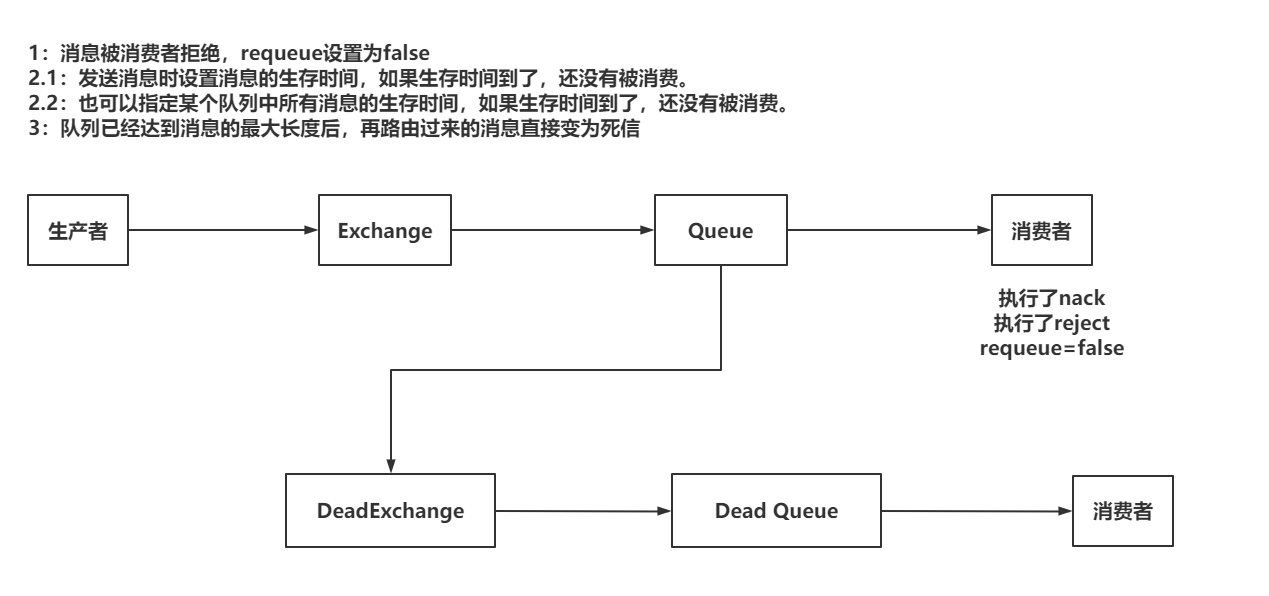 |
死信队列的应用:
- 基于死信队列在队列消息已满的情况下,消息也不会丢失
- 实现延迟消费的效果。比如:下订单时,有15分钟的付款时间
7.2 实现死信队列
7.2.1 准备Exchange&Queue
package com.mashibing.rabbitmqboot.config;
import org.springframework.amqp.core.*;
import org.springframework.context.annotation.Bean;
import org.springframework.context.annotation.Configuration;
/**
* @author zjw
* @description
* @date 2022/2/10 15:04
*/
@Configuration
public class DeadLetterConfig {
public static final String NORMAL_EXCHANGE = "normal-exchange";
public static final String NORMAL_QUEUE = "normal-queue";
public static final String NORMAL_ROUTING_KEY = "normal.#";
public static final String DEAD_EXCHANGE = "dead-exchange";
public static final String DEAD_QUEUE = "dead-queue";
public static final String DEAD_ROUTING_KEY = "dead.#";
@Bean
public Exchange normalExchange(){
return ExchangeBuilder.topicExchange(NORMAL_EXCHANGE).build();
}
@Bean
public Queue normalQueue(){
return QueueBuilder.durable(NORMAL_QUEUE).deadLetterExchange(DEAD_EXCHANGE).deadLetterRoutingKey("dead.abc").build();
}
@Bean
public Binding normalBinding(Queue normalQueue,Exchange normalExchange){
return BindingBuilder.bind(normalQueue).to(normalExchange).with(NORMAL_ROUTING_KEY).noargs();
}
@Bean
public Exchange deadExchange(){
return ExchangeBuilder.topicExchange(DEAD_EXCHANGE).build();
}
@Bean
public Queue deadQueue(){
return QueueBuilder.durable(DEAD_QUEUE).build();
}
@Bean
public Binding deadBinding(Queue deadQueue,Exchange deadExchange){
return BindingBuilder.bind(deadQueue).to(deadExchange).with(DEAD_ROUTING_KEY).noargs();
}
}
7.2.2 实现效果
-
基于消费者进行reject或者nack实现死信效果
package com.mashibing.rabbitmqboot; import com.mashibing.rabbitmqboot.config.DeadLetterConfig; import com.rabbitmq.client.Channel; import org.springframework.amqp.core.Message; import org.springframework.amqp.rabbit.annotation.RabbitListener; import org.springframework.stereotype.Component; import java.io.IOException; /** * @author zjw * @description * @date 2022/2/10 15:17 */ @Component public class DeadListener { @RabbitListener(queues = DeadLetterConfig.NORMAL_QUEUE) public void consume(String msg, Channel channel, Message message) throws IOException { System.out.println("接收到normal队列的消息:" + msg); channel.basicReject(message.getMessageProperties().getDeliveryTag(),false); channel.basicNack(message.getMessageProperties().getDeliveryTag(),false,false); } } -
消息的生存时间
-
给消息设置生存时间
@Test public void publishExpire(){ String msg = "dead letter expire"; rabbitTemplate.convertAndSend(DeadLetterConfig.NORMAL_EXCHANGE, "normal.abc", msg, new MessagePostProcessor() { @Override public Message postProcessMessage(Message message) throws AmqpException { message.getMessageProperties().setExpiration("5000"); return message; } }); } -
给队列设置消息的生存时间
@Bean public Queue normalQueue(){ return QueueBuilder.durable(NORMAL_QUEUE) .deadLetterExchange(DEAD_EXCHANGE) .deadLetterRoutingKey("dead.abc") .ttl(10000) .build(); }
-
-
设置Queue中的消息最大长度
@Bean public Queue normalQueue(){ return QueueBuilder.durable(NORMAL_QUEUE) .deadLetterExchange(DEAD_EXCHANGE) .deadLetterRoutingKey("dead.abc") .maxLength(1) .build(); }只要Queue中已经有一个消息,如果再次发送一个消息,这个消息会变为死信!
7.3 延迟交换机
下载地址:https://github.com/rabbitmq/rabbitmq-delayed-message-exchange/releases/tag/3.8.9
死信队列实现延迟消费时,如果延迟时间比较复杂,比较多,直接使用死信队列时,需要创建大量的队列还对应不同的时间,可以采用延迟交换机来解决这个问题。
-
构建延迟交换机
package com.mashibing.rabbitmqboot.config; import org.springframework.amqp.core.*; import org.springframework.context.annotation.Bean; import org.springframework.context.annotation.Configuration; import java.util.HashMap; import java.util.Map; /** * @author zjw * @description */ @Configuration public class DelayedConfig { public static final String DELAYED_EXCHANGE = "delayed-exchange"; public static final String DELAYED_QUEUE = "delayed-queue"; public static final String DELAYED_ROUTING_KEY = "delayed.#"; @Bean public Exchange delayedExchange(){ Map<String, Object> arguments = new HashMap<>(); arguments.put("x-delayed-type","topic"); Exchange exchange = new CustomExchange(DELAYED_EXCHANGE,"x-delayed-message",true,false,arguments); return exchange; } @Bean public Queue delayedQueue(){ return QueueBuilder.durable(DELAYED_QUEUE).build(); } @Bean public Binding delayedBinding(Queue delayedQueue,Exchange delayedExchange){ return BindingBuilder.bind(delayedQueue).to(delayedExchange).with(DELAYED_ROUTING_KEY).noargs(); } } -
发送消息
package com.mashibing.rabbitmqboot; import com.mashibing.rabbitmqboot.config.DelayedConfig; import org.junit.jupiter.api.Test; import org.springframework.amqp.AmqpException; import org.springframework.amqp.core.Message; import org.springframework.amqp.core.MessagePostProcessor; import org.springframework.amqp.rabbit.core.RabbitTemplate; import org.springframework.beans.factory.annotation.Autowired; import org.springframework.boot.test.context.SpringBootTest; /** * @author zjw * @description */ @SpringBootTest public class DelayedPublisherTest { @Autowired private RabbitTemplate rabbitTemplate; @Test public void publish(){ rabbitTemplate.convertAndSend(DelayedConfig.DELAYED_EXCHANGE, "delayed.abc", "xxxx", new MessagePostProcessor() { @Override public Message postProcessMessage(Message message) throws AmqpException { message.getMessageProperties().setDelay(30000); return message; } }); } }
八、RabbitMQ的集群
RabbitMQ的镜像模式
| RabbitMQ的集群 |
|---|
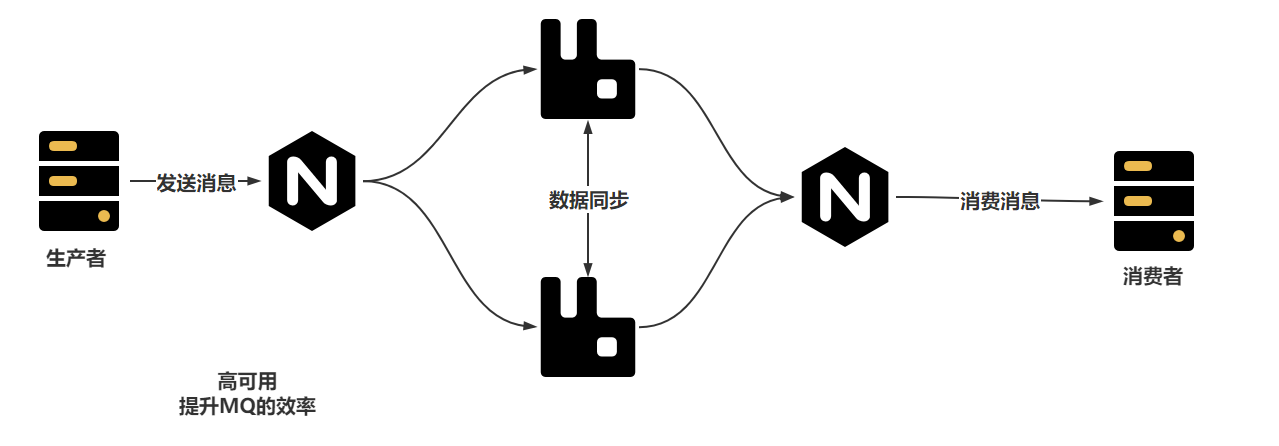 |
高可用
提升RabbitMQ的效率
搭建RabbitMQ集群
-
准备两台虚拟机(克隆)
-
准备RabbitMQ的yml文件
rabbitmq1:
version: '3.1' services: rabbitmq1: image: rabbitmq:3.8.5-management-alpine container_name: rabbitmq1 hostname: rabbitmq1 extra_hosts: - "rabbitmq1:192.168.11.32" - "rabbitmq2:192.168.11.33" environment: - RABBITMQ_ERLANG_COOKIE=SDJHFGDFFS ports: - 5672:5672 - 15672:15672 - 4369:4369 - 25672:25672rabbitmq2:
version: '3.1' services: rabbitmq2: image: rabbitmq:3.8.5-management-alpine container_name: rabbitmq2 hostname: rabbitmq2 extra_hosts: - "rabbitmq1:192.168.11.32" - "rabbitmq2:192.168.11.33" environment: - RABBITMQ_ERLANG_COOKIE=SDJHFGDFFS ports: - 5672:5672 - 15672:15672 - 4369:4369 - 25672:25672准备完毕之后,启动两台RabbitMQ
启动效果 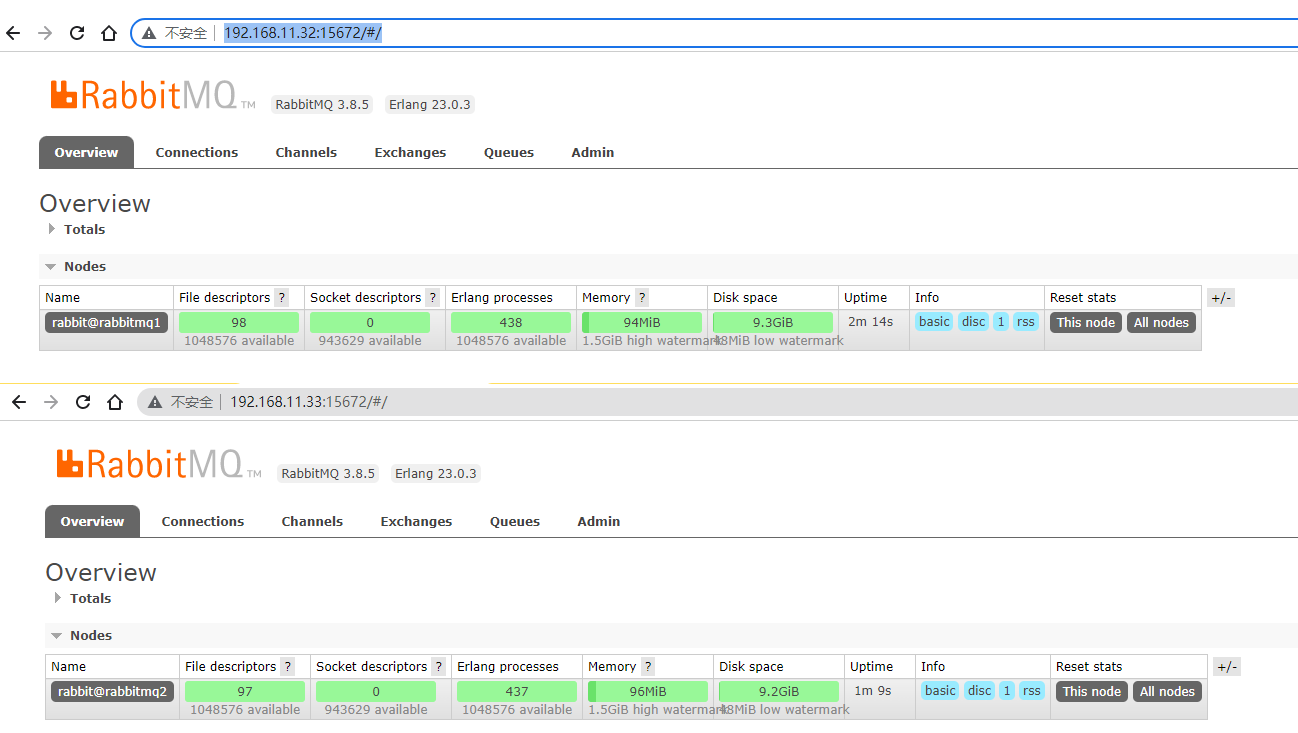
-
让RabbitMQ服务实现join操作
需要四个命令完成join操作
让rabbitmq2 join rabbitmq1,需要进入到rabbitmq2的容器内部,去执行下述命令
rabbitmqctl stop_app rabbitmqctl reset rabbitmqctl join_cluster rabbit@rabbitmq1 rabbitmqctl start_app执行成功后:
执行成功后 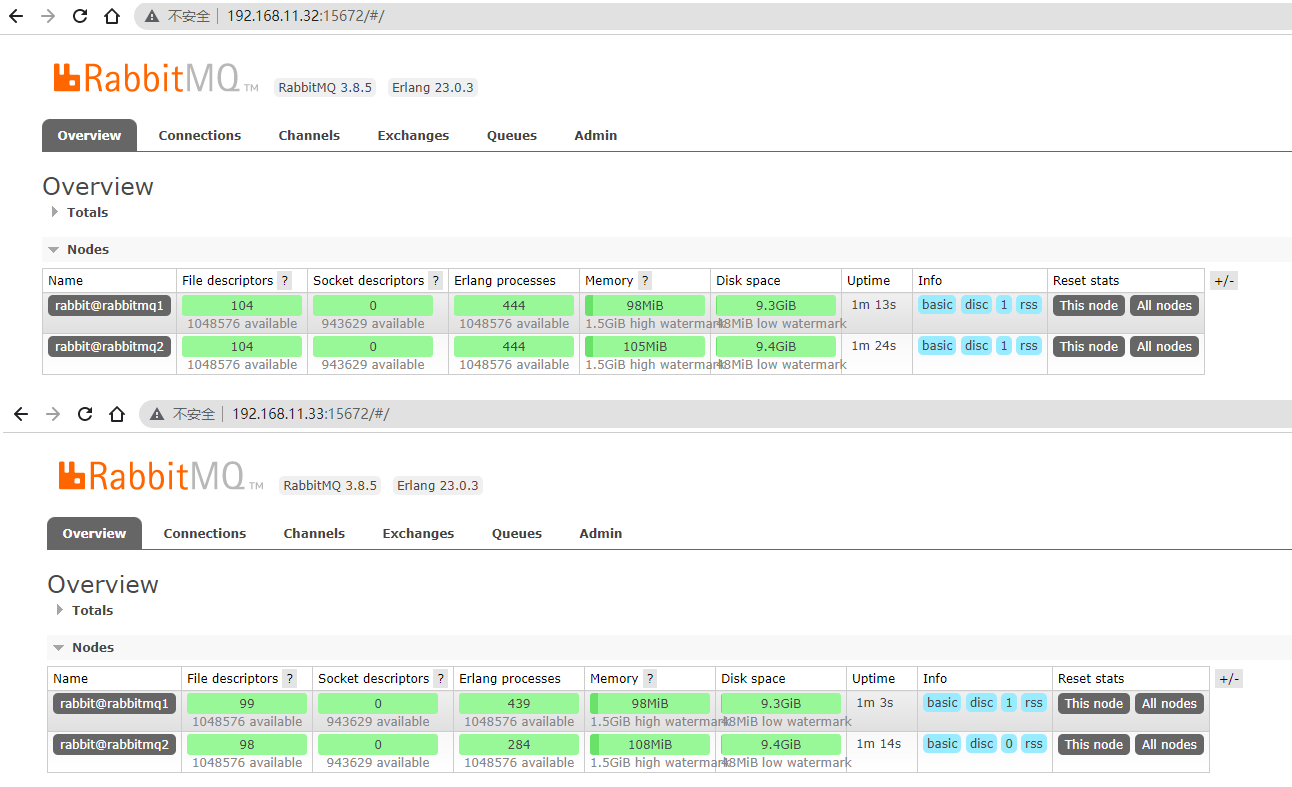
-
设置镜像模式
在指定的RabbitMQ服务中设置好镜像策略即可
镜像模式 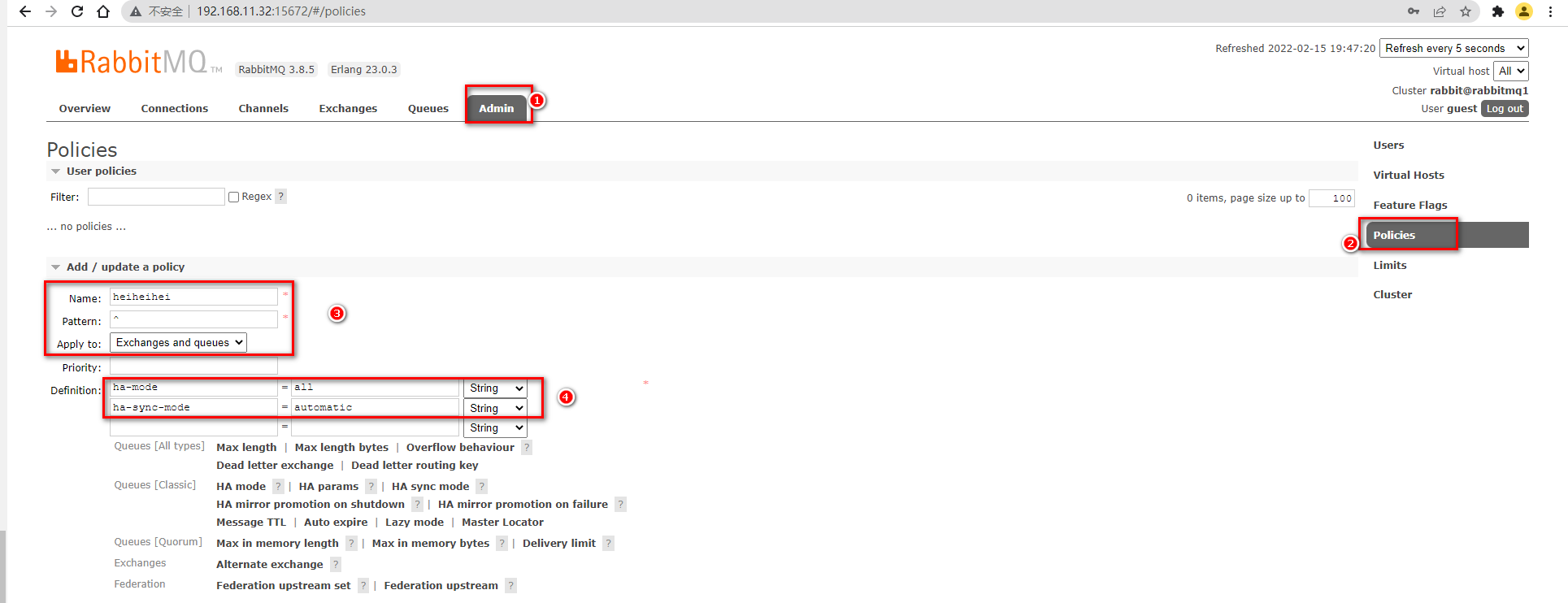
九、RabbitMQ其他内容
9.1 Headers类型Exchange
headers就是一个基于key-value的方式,让Exchange和Queue绑定的到一起的一种规则
相比Topic形式,可以采用的类型更丰富。
| headers绑定方式 |
|---|
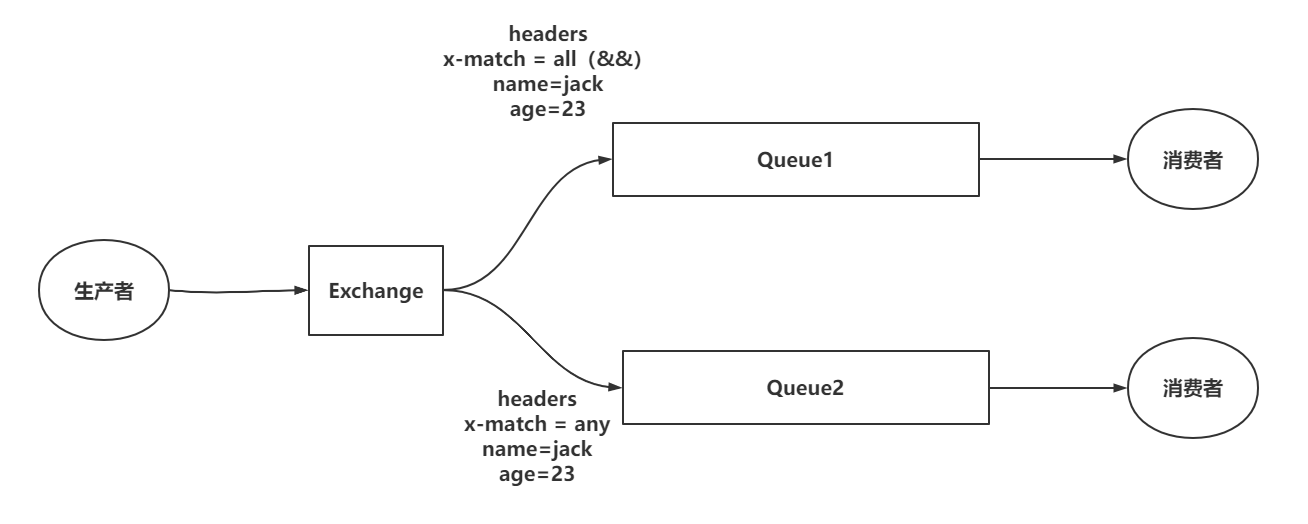 |
具体实现方式
package com.mashibing.headers;
import com.mashibing.util.RabbitMQConnectionUtil;
import com.rabbitmq.client.AMQP;
import com.rabbitmq.client.BuiltinExchangeType;
import com.rabbitmq.client.Channel;
import com.rabbitmq.client.Connection;
import org.junit.Test;
import java.util.HashMap;
import java.util.Map;
/**
* @author zjw
* @description
*/
public class Publisher {
public static final String HEADER_EXCHANGE = "header_exchange";
public static final String HEADER_QUEUE = "header_queue";
@Test
public void publish()throws Exception{
//1. 获取连接对象
Connection connection = RabbitMQConnectionUtil.getConnection();
//2. 构建Channel
Channel channel = connection.createChannel();
//3. 构建交换机和队列并基于header的方式绑定
channel.exchangeDeclare(HEADER_EXCHANGE, BuiltinExchangeType.HEADERS);
channel.queueDeclare(HEADER_QUEUE,true,false,false,null);
Map<String,Object> args = new HashMap<>();
// 多个header的key-value只要可以匹配上一个就可以
// args.put("x-match","any");
// 多个header的key-value要求全部匹配上!
args.put("x-match","all");
args.put("name","jack");
args.put("age","23");
channel.queueBind(HEADER_QUEUE,HEADER_EXCHANGE,"",args);
//4. 发送消息
String msg = "header测试消息!";
Map<String, Object> headers = new HashMap<>();
headers.put("name","jac");
headers.put("age","2");
AMQP.BasicProperties props = new AMQP.BasicProperties()
.builder()
.headers(headers)
.build();
channel.basicPublish(HEADER_EXCHANGE,"",props,msg.getBytes());
System.out.println("发送消息成功,header = " + headers);
}
}
本文来自互联网用户投稿,该文观点仅代表作者本人,不代表本站立场。本站仅提供信息存储空间服务,不拥有所有权,不承担相关法律责任。 如若内容造成侵权/违法违规/事实不符,请联系我的编程经验分享网邮箱:chenni525@qq.com进行投诉反馈,一经查实,立即删除!
- Python教程
- 深入理解 MySQL 中的 HAVING 关键字和聚合函数
- Qt之QChar编码(1)
- MyBatis入门基础篇
- 用Python脚本实现FFmpeg批量转换
- 受“博比特虫”启发可实现多模态传感抓取动作的软执行器来了
- 三、安全工程—密码学(CISSP)
- 微信小程序基本使用2:wxs,组件的使用以及弹窗、滚动条
- Node.js(四)-express
- CEC2013(python):五种算法(HHO、WOA、GWO、DBO、PSO)求解CEC2013(python代码)
- UE4工程升级UE5教程及注意事项
- [原创]arch更新时出错:无法提交处理(有冲突的文件)npm文件系统中已存在,发生错误,没有软件包被更新
- Vue - 使用XLSX插件进行文件导出
- 【Leetcode】移除后集合的最多元素数
- C语言——整型数据类型